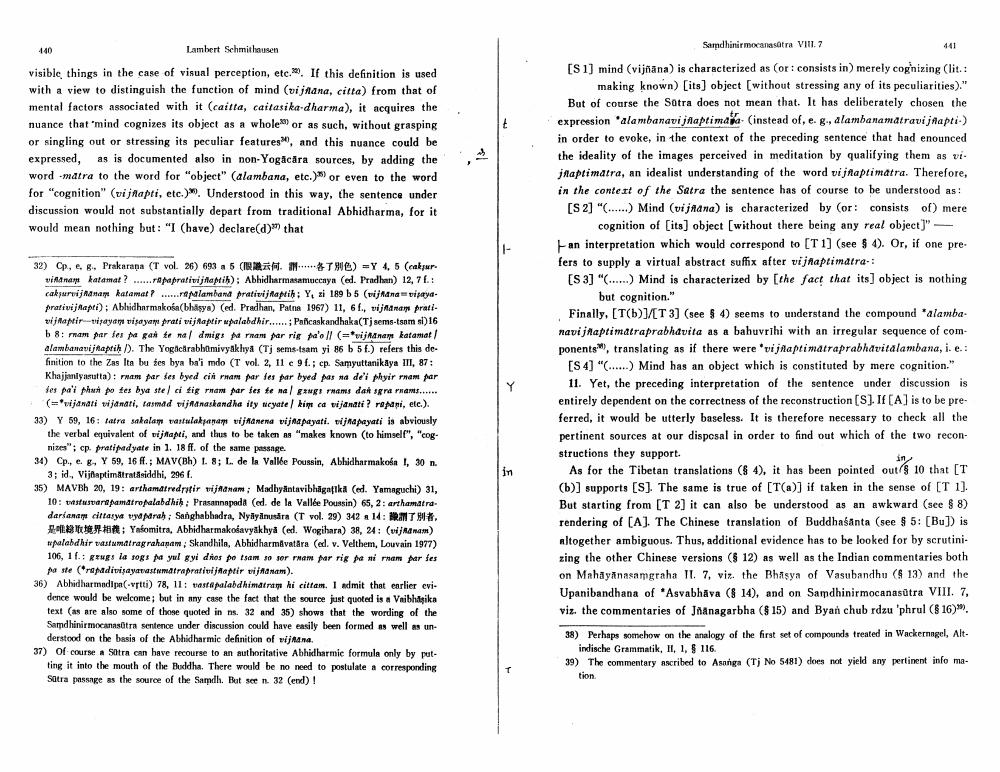Book Title: On Vinaptimatra Passage In Samadhinirmocanasutra VIII Author(s): L Schmithausen Publisher: L Schmithausen View full book textPage 5
________________ Lambert Schmithausen Sardhinirmanastra VIII 7 visible things in the case of visual perception, etc.). If this definition is used with a view to distinguish the function of mind (vijnana, citta) from that of mental factors associated with it (caitta, caitasika-dharma), it acquires the nuance that mind cognizes its object as a whole or as such, without grasping or singling out or stressing its peculiar features, and this nuance could be expressed, as is documented also in non-Yogacara sources, by adding the word -matra to the word for "object" (alambana, etc.)" or even to the word for "cognition" (vijnapti, etc.)". Understood in this way, the sentence under discussion would not substantially depart from traditional Abhidharma, for it would mean nothing but: "I (have) declare(d) that 1 32) Cp, g. Prakarana (T vol. 26) 6935 CHRIRAM. M T 98) =Y 4, 5 (calpur viflanan katamat? ...... papratiwijiapis): Abhidharmasamuccaya (ed. Pradhan) 12,7.: cakurvijana halamat? .... F lamband Aratinjani: Y, 1895 (wi Manaviy prativi Aapi); Abhidharmakosa(bhasya) (ed. Pradhan, Patna 1967) 11, 6., vijay Prati wij afir-visayagi visayaw pratiwijaptirpalabdhir...... Pacarkandhaka(Tj sems-tsom si) 16 b 8: mam par les m al tema d mig! Mirman par rie Maloll ( vijnanay katamat alambawavijnaprih!). The Yogicrabbamivyakhya (Tj nemstram yi 86 b 5.) refers this de finition to the Zas Ita bu ten byn bli mdo (T vol. 2, 11 e 96 cp. Samyuttanikaya III, 87: Khajanlynutta): ram par les byed il ram par les par dyed My ma del Myir ram par des pall Mhu o to by stel tir ran par les te ma am dat seams...... (wjaali wanati, famad vijanaskandha ity wegate mea wijani ? romani, etc.). 33) Y 69, 16: tatra kalan rawlakanam wijnen Wijn Mayall Wijna tati is abviously the verbal equivalent of japi, and thus to be taken a "makes known (to himself", "cog nizes": cp pretipadyate in 1. 18 ft. of the same passage. 34) Cp, ex. Y 59, 16 ff.; MAV(Bh) L8; L de la Vallée Poussin, Abhidharmakon I. 30 n. 3; id, Vijaptim.Atratasiddhi, 296. 35) MAVBh 20, 19: arthamdireditir mjanom: Madhy Antavibhigafika (ed. Yamaguchi) 31, 10: mareamiro falabdhib: Prasannapada (ed. de In Vallée Poussin) 65,2: arthamatra dariansy dittasys syarah: Sanghabhadra, Nyayanuskra (T vol. 29) 342 & 14:10MT81* n : Yafomitra, Abhidharmakokavyakhya (ed. Wagihara) 38, 24: (wijam) spalahdhir taalumatragraharam, Skandhin, Abhidharmintra (ed. v. Velthem, Louvain 1977) 106, 11. krugla og myul gyi dhe po tm 10 or ram Mr PR M irnam Aer les pse (rendi starapraturtir WiMam). 36) Abhidharmadipa vrti) 78, 11: Palabdhimdir Nielttan. I admit that earlier evi dence would be welcome; but in any case the fact that the source is quoted is a Vaibharika text (as are also some of those quoted in m. 32 and 35) shows that the wording of the Samdhinir mecanestra sentence under discussion could have easily been formed as well as un derstood on the basis of the Abhidharmic definition of wij Ana 37) Of course Sotra can have recourse to an authoritative Abhidharmic formula only by put ting it into the mouth of the Buddha. There would be no need to postulate a corresponding Sotra passage as the source of the Sandh. But seen 32 (end)! [S1) mind (vijñāna) is characterized as Cor: consists in) merely cognizing (lit: making known) [its) object (without stressing any of its peculiarities)." But of course the Sotra does not mean that. It has deliberately chosen the expression 'alambanavijnaptimaa (instead of, e. 8., alambana maravij Aapti.) in order to evoke, in the context of the preceding sentence that had enounced the ideality of the images perceived in meditation by qualifying them as ve japtimatra, an idealist understanding of the word vijfaptimatra. Therefore, in the context of the Satra the sentence has of course to be understood as: [S2] "(.....) Mind (vijnana) is characterized by Cor: consists of) mere cognition of Cits) object (without there being any real object)" - an interpretation which would correspond to [T1] (see $ 1). Or, if one prefers to supply a virtual abstract suffix after vijnaptimatra.: [S3] "(.....) Mind is characterized by the fact that its] object is nothing but cognition." Finally, [T(b)]/[T3J (see $ 4) seems to understand the compound 'alamba navijnaptimatraprabhavita as a bahuvrihi with an irregular sequence of components, translating as if there were 'vijnaprimairaprabhavitalambana, i.e. [S4] "C......) Mind has an object which is constituted by mere cognition." 11. Yet, the preceding interpretation of the sentence under discussion is entirely dependent on the correctness of the reconstruction (S). IF(A) is to be preferred, it would be utterly baseless. It is therefore necessary to check all the pertinent sources at our disposal in order to find out which of the two reconstructions they support. As for the Tibetan translations ( 1), it has been pointed out($ 10 that [T (b)] supports [S]. The same is true of [T(a)] if taken in the sense of [T1]. But starting from [T 2] it can also be understood as an awkward (see $ 8) rendering of (AJ. The Chinese translation of Buddhasanta (see & 5: (Bu]) is altogether ambiguous. Thus, additional evidence has to be looked for by scrutini zing the other Chinese versions ($ 12) as well as the Indian commentaries both on Mahayanasamgraha II. 7vir. the Bhasya of Vasubandhu (13) and the Upanibandhana of Asvabhava (14), and on Samdhinirmocanastra VIII. 7, viz. the commentaries of Jhanagarbha ($15) and Byan chub rdzu 'phrul (16)". 38) Perhaps somehow on the analogy of the first set of compounds treated in Wackernagel, Alt indische Grammatik, I, 1, $ 116. 39) The commentary scribed to Asanga (Tj No 5181) does not yield any pertinent info ma tionPage Navigation
1 ... 3 4 5 6 7 8 9 10 11 12
